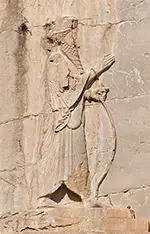Thursday, August 14, 2025
Xerxes the Great: Persian Emperor, Foe of Greece
Xerxes I was a well-known ruler of the Persian Empire. The son of Darius the Great, he is perhaps most well-known for leading an invasion of Greece that ended in defeat. 
He was born in 419 B.C. He had an older brother, Artobazan. Darius died in 486 B.C. Xerxes and Artobazan both contested the throne. The usual practice was that the older son would succeed his father as king. However, Xerxes could claim, as Artobazan could not, that his mother was the daughter of the Persian Empire founder Cyrus the Great. Artobazan's mother was a commoner. The nobles decided to honor the royal bloodline. Eventually, younger son succeeded father on the throne and, after intense encouragement by Mardonius, a general who had fought in the previous and wanted to avenge that defeat, resolved to succeed in Greece where his father had not. He instituted new taxes, which created revolts, none moreso than in Babylon. The king responded with brute force, ordering his troops to sack the city, wreck the major temple, and melt down a large gold statue of the chief local god, Marduk, for the wealth that the gold would bring. 
Xerxes assembled an army and navy larger than his father had and invaded Greece, in 480 B.C. His invasion was notable for his method of transporting his troops across the Hellespont: He ordered more than 300 ships to be lined up side by side and then ordered built a bridge made of flax and papyrus. (Xerxes displayed his famous temper by, after being informed that the waters of the Hellespont had washed away one of the "pontoons," ordered the sea whipped for insubordination.) The army was so large that it took seven days and nights for all of them to cross. After an initial yet militarily expensive victory at the Battle of Thermopylae, Xerxes himself watched the Greeks outsail and destroy the Persian fleet at Salamis and then took a large part of his army home. The Persian army that stayed behind found itself defeated again, at the Battle of Plataea in 479 B.C. No further Persian invasion of Greece was forthcoming. Xerxes turned his attention to within his own borders, embarking on building projects to burnish his legacy. He completed projects left half-finished by his and his father's wars and improved the Royal Road. He had also ordered built the Gate of All Nations and the Hall of a Hundred Columns. He married a woman namaed Amestris; they had six children together. Xerxes I died in 465 B.C., at the hands of Artabanus, the head of the royal bodyguard, who planned to declare himself king. Artaxerxes, a son of Xerxes, dispatched Artabanus and took the throne. |
|
Social Studies for Kids
copyright 2002–2024
David White




